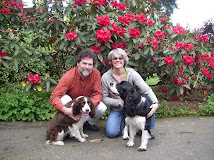As our time in Italy winds down, we still have a long list of things we
want to do and see before we leave. In August, we checked off one of those things:
the Haute Route, a high-alpine traverse between the iconic mountain towns of Chamonix, France, and Zermatt, Switzerland.
The Haute Route, which was
established in the 1880s by the British Alpine Club, captured our imagination when
we spent the summer of 1993 climbing in the Alps. But that summer we were busy
bagging peaks and the Haute Route was not the challenge we were craving. Twenty
years later, and nearly past our peak bagging days, we were ready for the Haute
Route.
 |
| Dent D'Herens, one of the peaks we bagged 20 years ago. |
Only 45 miles long, the route took us 7 days to ascend and descend nearly 18,000 feet. There was nothing technical about the hike, but we did travel over half a dozen glaciers, so axes, crampons, and a rope were required. We carried little else in our packs, because we were staying in mountain huts up high and simple hotels down in the valleys.
 |
| Our route, including a long dotted section which entailed hiring a taxi! |
Europe’s hut system comes as a surprise to North American hikers and climbers who are used to schlepping tent, stove, fuel, food, sleeping bag, and pad. Euro mountain huts offer dormitory-style accommodations and simple, but hearty food. They cater to hikers, climbers, and skiers of all ages. They aren’t fancy but they are often quaint, full of camaraderie, and in spectacular locations, like the Bertol hut, perched atop a rock outcrop and only reached by climbing a series of permanent ladders. The huts aren’t cheap—an average hut price for two of us with meals (and wine!) was $150—but given where you are, the price is fair.
 |
| The final set of ladders to reach the Bertol Hut. |
The advantage of the hut system is that people of all ages and fitness levels can enjoy nature and be inspired by some of the most stunning mountain scenery in the world. The disadvantage is that it can be crowded. Our first hut had about 200 people spending the night. Nearly everyone woke up at 5, had breakfast, and then hit the glacier. This is not a wilderness experience where you commune with nature, and if you are on a popular route, you can find
yourself being slowed down by groups ahead of you and pressured by groups behind you. So when climbing or hiking in the Alps, we have learned to embrace the infrastructure, and lower our expectations for solitude and wildlife encounters. We’ll save those experiences for North America.
Here is a link to some photos from the trip. Sadly, Jim forgot his battery charger for his camera, so we relied on my little camera for these photos. There are also a few pictures of our trip from before and after the Haute Route. We spent two days getting to the Haute Route and three coming home. Almost more than anything, we will miss riding our motos here. One blissful curve after another and we realize that despite the intensity, or maybe because of it, we are always smiling.









































